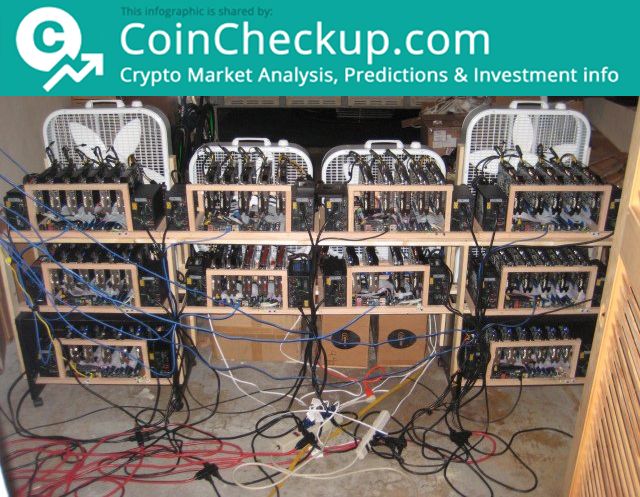To the chagrin of many enthusiasts, the notorious “native” in 2018 did not take place. The prices of bitcoin and most other cryptoactive assets are much lower than at the end of last year. The market is still looking for a foothold after a protracted correction, replaced by a stinging flat.
However, in this situation there is nothing out of the ordinary. At least, this opinion is shared by Charlie Bilello, Pension Partners researcher, who gives a chart of maximum Bitcoin drawdowns since 2010:
Historical drawdowns in Bitcoin … pic.twitter.com/G32erDbg76
– Charlie Bilello (@charliebilello) November 21, 2018
Many are confident that the market will recover over time. Nevertheless, the ongoing deep recession has a serious impact on mining profitability right now. If in 2017 it was extremely cost-effective, even at home, now the situation is clearly the opposite. Evidence of this is the fall in hash rates due to the shutdown of tens of thousands of mining devices, lower farm prices and poor financial performance of Nvidia in the relevant segment.
Many have such questions :
- “Is it profitable to mine at home?”
- “Are there non-standard mining approaches on the energy-intensive Proof-of-Work algorithm?”
- “Is it possible to usefully use the heat generated by the equipment?”
Current situation: mining is now completely unprofitable?
As is known, the prices of most cryptocurrencies since the beginning of the year fell by 70-80%. It is quite natural that in such conditions miners become much smaller, since many types of equipment operate at a loss.
In particular, this thesis is confirmed by the mining expert and CEO of Acronym.Systems Matvey Sivoksha.
"We turned off all of our equipment except what is used for heating, and in addition to the farms on NVIDIA video cards ," he notes.
Almost also did the famous YouTube blogger Mister Xal. In his video, he says that he uses three farms on video cards mostly just to keep warm, not overpaying for electricity.
Three of its GPU farms produce 321 MH / s and at a rate of $ 0.06 per kWh of electricity, they generate $ 1.86 net profit per day. But, according to him, the room is not cold and it is not necessary, relatively speaking, to go "to the factory."
“It makes no sense to buy video cards now ,” the blogger stresses.
The question arises: is it possible to enter the mining now , extracting cryptocurrency for the future, that is, in the hope that the market will soon unfold and this occupation will become profitable?
Matvey Sivoraksha is convinced that there is no point in mining "minus" because it is faster and easier to immediately buy coins on the market. However, he notes, there may be different mining strategies:
“For example, if you have cheap electricity, there is hardly a better market than this one. After all, almost any type of equipment can now be purchased for a penny in comparison with peaks on the market. If there is a Fiat and you expect the market to recover, you can, for example, buy Nvidia farms on video cards at very, very modest prices. ”
Use of heat from mining
As is known, most of the energy consumed during the operation of the equipment is converted into thermal energy. With large mining farms, many have a desire to somehow use the heat that they emit.
That is, for example, the Czech entrepreneur and co-founder of NakamotoX Kamil Breicha. He used the heat of a mining farm to grow vegetables.
For the accumulation of heat and its subsequent direction into the greenhouses, the project team created the so-called “cointeners” and placed them in the basement. The crop grown thanks to the rational use of the heat obtained from the miners was dubbed cryptotomatics.
According to the entrepreneur, the mining equipment itself receives electricity generated from the processing of biowaste.
“In fact, we have a closed energy cycle ,” said Kamil Breicha.
A year ago, Irkutsk entrepreneurs were reported to have tested a mobile home, heated and provided with hot water exclusively from cryptocaval on the basis of two mining farms.
“Cryptocotel looks like a normal system unit, to which silicone tubes with a pink liquid – coolant are connected. Miners heat the liquid, which is then distributed through the house through pipes. This creates added value in the form of cryptocurrency. Of course, it is more profitable to heat this way , ”said one of the authors of the idea, Ilya Frolov.
Thus, in an unfavorable pricing environment on the crypto market, even if the equipment operates at a loss, you can get tangible benefits from the heat generated by miners.
Options for the use of this heat can be many. For example :
- heating of any reservoir – fisheries, swimming pool, etc.
- indoor air heating – office, workshop, private house, greenhouse, etc.
- heated floors in the house.
Of course, all these methods of heat recovery must be carefully considered.
Mining equipment "2.0"
Companies that not only create such hybrid solutions, but also design and install sometimes quite complex and powerful systems, are increasingly appearing on the market.
For example, Hotmine has been working on solutions of this kind since 2013. The company classifies its products in the mining 2.0 category.
Now the company is creating "miners-convectors" of various options and configurations that can be used for both small rooms and large objects.
Thus, the Bitfury-based Hotmine WX12 device can extract bitcoins at a hashing rate of 29 TH / s.
The unit has a power of 4 kW and it provides immersion cooling. The heat removed from the miner can heat the water in the heating system to 70 ° C.
In one of the videos this miner-boiler in action is demonstrated using the example of a private house:
The company creates and mining systems of high power. So, Hotmine Data Tank has a capacity of 500-570 Th / s.
It is also noted that the system consumes from 60 to 72 kW, weighs 600 kg and is capable of diverting more than 100 kW of thermal power.
In addition, Hotmine is currently creating a convector-miner, which, according to the developers, looks like a heating radiator and works quietly.
Such solutions, but already focused on the mining of altcoins, creates a Comino startup.
According to the developers, liquid cooling increases the performance of the video cards involved in it by 20%. The device works very quietly, giving out 200 Mh / s at mining Ethereum .
Also, according to Comino, the unit can be used as a home heater.
A similar, albeit somewhat less powerful solution, is offered by the French startup Qarnot. The QC-1 cryptoheater is equipped with two graphics cards – AMD Sapphire Nitro and Radeon RX580 8G, whose total performance is 60 MH / s.
Comino and Qarnot cryptoheaters look pretty elegant. However, the obvious disadvantages of these devices are their prices, which, against the background of a drop in the ETH mining profitability on video cards, seem to be extremely high. So, the price of the first device is € 4,500, and the second – € 2,900. Thus, it is unlikely that at the current price of Ethereum one should count on the fact that such “cryptoconvectors” will quickly pay off.
For example, if you believe the Nicehash calculator, then even at $ 0.06 per kWh, AMD RX 580 8 GB, a popular among the miners, brings $ 3.42 per month.
In addition, it is unlikely that the heat generated by these devices is enough to be considered as full-fledged heaters. Apparently, the practical use of such a convector-miners can only be in the offseason, or when used as an additional source of heat.
However, according to the Acronym.Systems head, the term “mining 2.0” may include not only the beneficial use of heat, but also completely different things:
“On the one hand, by“ mining 2.0 ”we can mean alternative ways of reaching a consensus, for example, Proof-of-Stake . On the other hand, it is the movement towards Fog Computing (fogging computing), when we use the power of mining equipment for useful calculations (for example, SONM). ”
In general, he stresses, decentralization is not limited to “calculations and calculations”. For example, there are significant prospects for the sphere of distributed data storage, which ensures the privacy of information, as well as its inaccessibility to the state and corporations.
Stylish mining devices
Despite the far from the best situation on the market, companies and their marketers are not discouraged by resorting to a variety of tricks. So, the firm Coinmine presented a device for the extraction of cryptocurrency, which looks like an Xbox game console.
Coinmine One offers several mining options: Ethereum and Ethereum Classic with a computing speed of 29 MH / s, Monero with 800 H / s, Zcash with 290 sols / s. The site states that the device is based on the AMD Radeon RX 570 4 GB graphics card.
The device consumes 120 watts, low noise – 40 dB – allows you to install it in a living room or office. The user can control the mining through an intuitive application for Android or iOS.
“We want to democratize the mining equipment market and lower barriers to entry into the cryptocurrency mining business ,” said Coinmine CEO, Farbud Nivi.
The start of sales of Coinmine One is tentatively scheduled for mid-December. Miner price will be $ 799.
We calculate the payback of the device from Coinmine with the same relatively small $ 0.06 per kWh. The calculator gives us that in a month such a device makes $ 3.40 profit, and only 14 cents a day.
Now we divide the miner's price by the monthly profit indicator: 799: 3.40 = 235 months.
It's almost 20 years old! In addition, the calculations did not take into account the highly probable increase in the complexity of Ethereum, as well as the decrease in the block reward as part of a gradual transition to the Proof-of-Stake consensus algorithm .
It is unlikely that the current market conditions Coinmine One can be considered as an investment. Considering that only one video card is used in the device, it is unlikely that it will not produce a significant amount of heat. Apparently, the device is designed for those who want to "feel" what is mining, while completely unwilling to bother with technical details.
Thus, despite the seemingly deplorable state of affairs in the mining industry, there are opportunities to adapt to the current situation and wait in the heat of the notorious “cryptozyme”. In all likelihood, mining rationalization solutions will continue to evolve. This, in turn, will contribute to the stabilization of the hashrate and the stability of the cryptoindustry in general.

